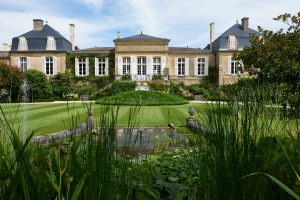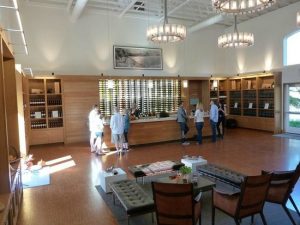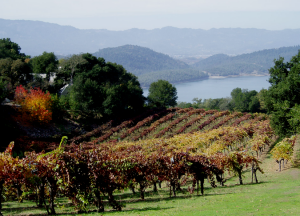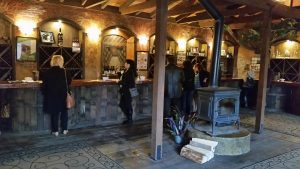There’s a lot to be said, both positive and negative, about wine tasting in Bordeaux. In fact we’ve already said some about the subject. What makes the snobbishness, the appointments and the limited variety of wines worth putting up with is, well, the wine. We are not the first to note that Bordeaux produces some of the world’s greatest wines. If you’re going to make the trip you really ought to taste the best of the best, and Château Léoville Barton (https://www.leoville-barton.com/) certainly falls into that category.
As with everything in Bordeaux, and especially the section north of the city called the Médoc, there’s a lot of history. Let’s start with the name, Château Léoville Barton. While there is a beautiful château to see when you visit, it is not properly speaking a château in winemaking terms. The grapes are actually pressed in the adjoining estate of Langoa Barton. However, they are blended and aged on the château property.

Photo courtesy of Château Léoville Barton.
You may recognize “Léoville” with names other than Barton after it. That’s because it was once a huge estate – the largest in Bordeaux, in fact – but was split up. That’s why you can find Léoville Las Cases and Léoville Poyferré as well. (An interesting tasting might be the three side-by-side. We’d love to do that someday.) The three are in the heart of St. Julien, an appellation known for sunny, approachable but profound wines. All were named as second growths, or deuxieme crus, in the 1855 ranking. That doesn’t always mean much today, but it certainly holds up for the Léovilles.
Finally, the name Barton comes from an 18th century Irishman named Thomas Barton who established himself in southern France and bought up some vineyards. (You may have heard of Barton & Guestier. Same Barton.) Power Tasting is all about the wine tasting experience, and when you are in a great Bordeaux château, the history is a part of the experience.
Your tour must be booked in advance and you had better arrive promptly. You will be met, escorted and explained to by your designated guide. Ours spoke English, but since Lucie was raised in French and Steve can get along, much of the tour was conducted in a mix of the two languages. If you have even a little French, you may get better explanations if you use that language.
Much of the tour is of the château itself, which is lovely in the same way that Downton Abbey is lovely. It is still the Barton family home. At one point, we were in a corridor with windows facing the gardens. We saw a man in running clothes jogging by with some hounds. Our guide exclaimed, “Oh, there goes the count!”
As on most winery tours, you get to see the blending and barrel rooms. The huge wooden tanks (not stainless steel as in the United States and even much of France) are quite impressive. Our guide told us that Léoville Barton still holds with tradition. We think that all that really matters is in the glass, so let both tradition and modernity reign. Of course, the rows of barrels full of future great wine does raise a thirst.
The tasting itself consists of two wines: Langoa Barton first and then Léoville Barton. (There is also a Léoville Barton second label, but we don’t remember it being offered.) Langoa Barton is itself a third growth, so it’s not shabby. Having the second growth Léoville Barton alongside – both made by the same people from grapes on adjoining ground – really brings out what makes one wine better, or at least different, from the other.
As we have said before, wine tasting in Bordeaux is snobbish like nowhere else in Wine Country, but it is worth going at least once. Let’s not forget, they have real châteaux there and they’ve been making great wine a long time before the New World did. You can taste their experience in the glass. Santé !





